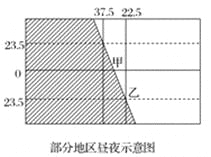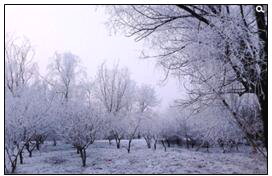��Ŀ����
����Ŀ����ͼΪij�ղ��ֵ�����ҹʾ��ͼ����Ӱ���ֱ�ʾ��ҹ�����ಿ�ֱ�ʾ���硣��ͼ�ش����⡣

��1�������������֣�ͼ����Ӱ������Ҫλ��____����ʱ�صط�ʱ��_______ʱ��
��2�����ϡ������֣���ʱ̫��ֱ���λ��_____����̫��ֱ���ľ�����________��
��3�������ҵصİ���ʱ�䳤Լ________Сʱ��
��4�������һ����ũ��ʮ�壬�Ϻ��������ǻ���Ҫ�ȴ�Լ_______Сʱ���ܿ���������������һ��Բ�¡�
��5�����������������ھ��ߵļн�Ϊ10�������������ʱ���Ϻ���31��N���������ݵ�̫���ܵ�ذ��뽨������ǽ�棨ǽ������洹ֱ��֮������ʵļн�ԼΪ________��
���𰸡���1���� 6
��2���� 60��E
��3��11
��4��2
��5��69��
�������������������1����ͼ��ͼ����Ӱ���ֱ�ʾ��ҹ�����ಿ�ֱ�ʾ���硣����ͼ�еľ��ȣ������������֣�20��W������160��E��������ͼ����Ӱ������Ҫλ��������ʱ��λ�ڳ��������Ľ����ϣ��ط�ʱ��6ʱ��
��2�� ���ϡ������֣���ʱ�������糤����ҹ����˵��̫��ֱ���λ�ڱ�������ͼ�м�λ�ã�λ��ͼʾ���������м䣬��30��W��ʱ����6�㡣̫��ֱ����ʱ����12�㣬���Լ����������60��E��
��3����ͼ������6�㣬�����ҵص��ճ�ʱ����6:30�������糤���㷽�����ҵذ���ʱ�䳤Լ11Сʱ��
��4�������һ����ũ��ʮ�壬�Ϻ���γ�����ҵ�γ�Ƚӽ����糤ʱ�����ҵ�ҹ��ʱ�����ƣ����Լ�����Ϻ�������ʱ��Լ18:30����ʱ����2����ʱ6�㣬����ʱ����16�㣬�Ϻ������������ٻ���Ҫ�ȴ�Լ2Сʱ�����ܿ���������������һ��Բ�¡�
��5�����������������ھ��ߵļн�Ϊ10���������̫��ֱ��γ����10��N���Ϻ���31��N��������̫���߶Ƚ���69�����������ݵ�̫���ܵ�ذ�Ҫ��̫�����ߴ�ֱ��Ч����á����Ե�ذ���ˮƽ��н���21�����뽨������ǽ�棨ǽ������洹ֱ��֮������ʵļн�ԼΪ69����

 ȫ�ܲ����ĩС״Ԫϵ�д�
ȫ�ܲ����ĩС״Ԫϵ�д�
